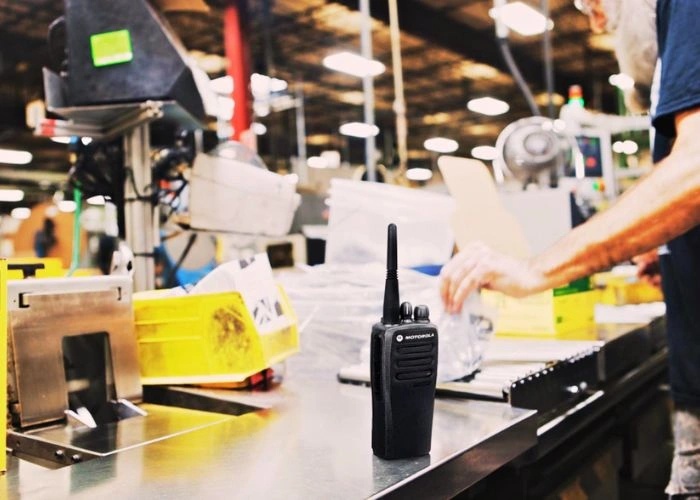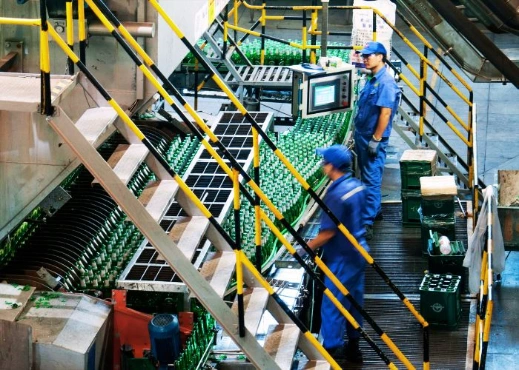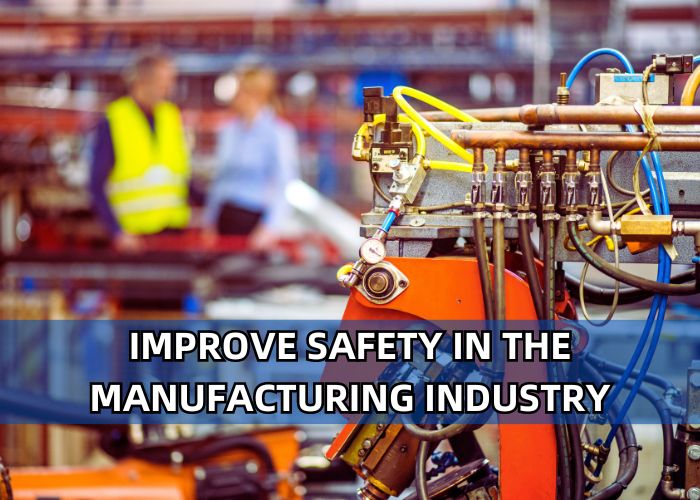Safety is a cornerstone of success in the manufacturing industry. At EMCI Wireless, we specialize in Solving for Safer, offering cutting-edge solutions to bolster workplace safety. As a leading provider and reseller of Motorola portable radios, we understand that safety is more than just a regulatory requirement—it’s the bedrock upon which efficiency and productivity thrive. Our mission is to equip you with the tools to build a robust safety foundation.
Understanding the Manufacturing Industry
The manufacturing industry encompasses various processes aimed at producing goods through a blend of human labor, automated machinery, chemical processes, and specialized tooling. It typically involves several key steps, including fabrication, processing, and preparation of goods, often starting from raw materials and culminating in products ready for sale through both business-to-consumer (B2C) and business-to-business (B2B) channels.
Within this industry, tasks and environments can vary widely. For instance, in automotive manufacturing, workers might assemble intricate parts on an assembly line, while in food processing, employees handle machinery to package and preserve perishable goods. Similarly, the aerospace sector involves precision engineering and assembly of aircraft components, while pharmaceutical manufacturing requires adherence to strict quality control measures during drug production.
However, amidst the innovation and production, manufacturing also poses inherent risks. These include potential accidents involving heavy machinery, exposure to hazardous chemicals, repetitive strain injuries from manual labor, and the threat of equipment malfunctions leading to production delays or defects. Ensuring safety in this environment is a non-negotiable to ensure the safety of workers and customers.
5 Ways to Improve Safety
As we explore some strategies to enhance safety in the manufacturing industry, we must acknowledge a sobering statistic: roughly 80 to 95% of accidents stem from unsafe behaviors, often intertwining with other unfavorable aspects inherent in workflow processes or existing within the working environment.
However, proactive measures can significantly mitigate risks and cultivate a safer workplace culture despite this challenge. Let’s explore five key ways to fortify safety, safeguarding both personnel and operational continuity.
1. Creating a Safety Culture
Cultivating a culture with a safety-first mindset among employees is the first priority. When safety becomes ingrained in the organizational ethos, employees are more likely to proactively identify and address potential hazards, leading to fewer accidents and enhanced overall well-being.
To promote safety awareness effectively, consider implementing the following strategies:
- Regular Training Sessions: Conduct frequent training sessions covering topics such as proper equipment usage, emergency procedures, and hazard recognition. Continuous education empowers employees to make informed decisions and reinforces safety protocols.
- Safety Incentives: Introduce incentives to recognize individuals or teams demonstrating exemplary safety practices. Whether through monetary rewards, accolades, or additional time off, incentives motivate employees to uphold safety standards and set positive examples for their peers.
- Recognition Programs: Establish a formal recognition program to celebrate achievements in safety. Publicly acknowledging individuals who contribute to a safer work environment fosters a sense of pride and reinforces the importance of safety as a collective responsibility.
By incorporating these strategies into the organizational framework, companies can foster a safety culture that permeates every aspect of operations, ultimately reducing accidents and promoting employee well-being.
2. Maintaining a Clean and Organized Workplace
Maintaining a clean and organized workplace is integral to ensuring the safety and efficiency of manufacturing operations. A clutter-free environment reduces tripping hazards and promotes productivity by streamlining workflows and minimizing distractions.
Implementing the 5S methodology, consisting of Sort, Set in Order, Shine, Standardize, and Sustain, offers a systematic approach to workplace organization endorsed by the Environmental Protection Agency. This methodology encourages employees to actively participate in organizing, cleaning, and sustaining a productive work environment.
By adhering to the principles of 5S, companies can instill a culture of continuous improvement and waste reduction. Workers are empowered to optimize their workspaces, leading to decreased unplanned downtime, improved inventory management, and enhanced overall efficiency.
3. Ensuring Proper Equipment Usage
In the manufacturing industry, using various types of equipment poses inherent risks to workers’ safety. These assets, from heavy machinery to specialized tools, demand meticulous attention to ensure safe operation. Proper training on correctly handling and using machinery and tools is paramount to mitigate the risk of accidents and injuries. To minimize potential hazards, employees must be well-versed in operational procedures, safety protocols, and emergency response measures.
Furthermore, routine maintenance and inspections are crucial in preventing equipment malfunctions and accidents. Regular checks ensure that machinery is in optimal condition, identifying and addressing potential issues before they escalate.
By prioritizing maintenance schedules and conducting thorough inspections, companies can uphold equipment reliability, enhance workplace safety, and safeguard both personnel and operational continuity. Investing in comprehensive training programs and maintenance protocols demonstrates the commitment to prioritizing safety in manufacturing environments.
4. Enabling Flow of Communication
Two-way radios are indispensable tools for fostering seamless communication among various stakeholders within the manufacturing industry. By enabling instant and direct communication between workers, supervisors, and emergency response teams, two-way radios facilitate real-time information exchange crucial for maintaining operational efficiency and ensuring safety.
Communicating quickly can make all the difference in critical situations, such as equipment malfunctions or safety hazards. For instance, a worker encountering a potential hazard can quickly alert supervisors or safety personnel via a two-way radio, prompting immediate action to mitigate risks and prevent accidents. Similarly, in emergency scenarios, rapid communication allows for swift coordination of response efforts, ensuring that appropriate measures are taken promptly to safeguard personnel and minimize disruptions to operations.

5. Creating Emergency Action Plans
Creating comprehensive emergency action plans is essential for ensuring the safety of employees in the manufacturing industry. These plans encompass various scenarios, including emergency exits, procedures for handling workplace injuries, protocols for equipment malfunctions, and responses to fires or natural disasters. By having a well-defined action plan in place, companies can effectively mitigate risks and minimize potential harm to personnel and property.
Regular training on emergency action plans is a must to ensure that employees are prepared to respond effectively in critical situations. Two-way radios are crucial in facilitating communication during emergencies, enabling swift coordination of response efforts, and disseminating crucial information.
By integrating two-way radios into emergency action plans, companies can enhance their emergency response capabilities, enabling seamless communication among employees, supervisors, and emergency response teams. This proactive approach to safety protects personnel and strengthens the manufacturing operation’s overall resilience in the face of unforeseen challenges.

EMCI Wireless is Your Partner for Two-Way Radios in the Manufacturing Industry
Here’s how EMCI Wireless can integrate Motorola Solutions’ ecosystem to contribute to a safer manufacturing environment:
Two-Way Radios and Push-to-Talk (PTT) Solutions:
Motorola Solutions provides robust two-way radio systems and PTT solutions that enable instant communication among workers across the manufacturing facility. This real-time communication capability ensures that workers can quickly report safety hazards, coordinate tasks, and request assistance in case of emergencies, while utilizing a device that is rugged and loud for tough work environments.
Video Surveillance and Access Control Systems:
Motorola Solutions offers advanced video surveillance and access control systems to monitor manufacturing facilities and restrict unauthorized access to sensitive areas. Video analytics capabilities provide valuable insights into safety compliance, identify potential hazards, and facilitate incident investigations.
- A manufacturing facility utilizes Motorola’s video surveillance system to monitor high-risk areas such as loading docks and machinery operation zones. When an unauthorized person attempts to access a restricted area, the system sends an alert to security personnel, who can intervene and prevent safety violations.
Worker Safety Solutions:
Motorola Solutions prioritizes worker safety with two-way radios equipped with advanced safety features such as emergency buttons, lone worker monitoring, and man down detection. These radios provide workers with a means to summon help quickly in emergency situations and enable supervisors to track their whereabouts in real-time.
- A lone worker operating heavy machinery in a remote section of a manufacturing plant experiences a medical emergency and becomes incapacitated. The worker’s radio device detects the lack of movement and sends an automatic distress signal to nearby colleagues and supervisors, who rush to provide assistance, potentially saving the worker’s life.
Prioritizing safety in the manufacturing industry is paramount for ensuring the well-being of employees and maintaining operational efficiency. To summarize, companies can mitigate risks and create a safer work environment through strategies such as fostering a safety culture, maintaining a clean and organized workplace, ensuring proper equipment usage, enabling effective communication, and creating emergency action plans.
As your partner for two-way radios in the manufacturing industry, EMCI Wireless is committed to providing cutting-edge communication solutions to enhance safety and productivity. With our expertise as a leading Motorola Solutions Channel Partner serving Central and South Florida, we stand ready to support your safety initiatives and help you build a safer, more resilient workplace. Contact EMCI Wireless today to learn more about our solutions and how we can assist your organization in prioritizing safety.






